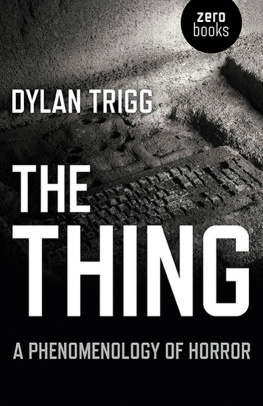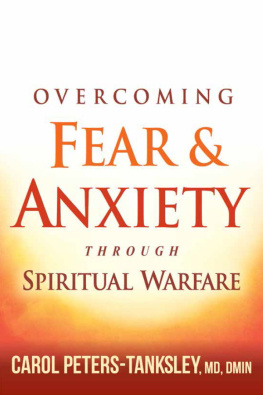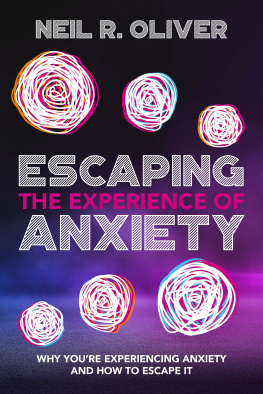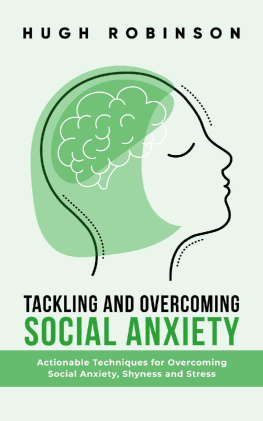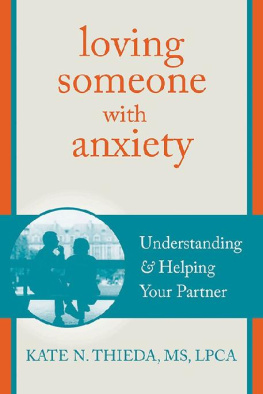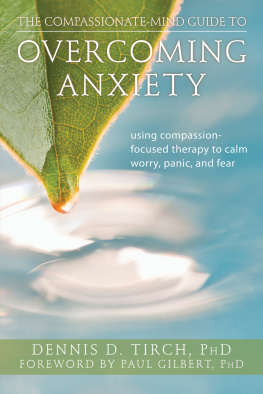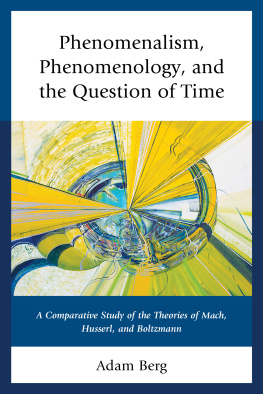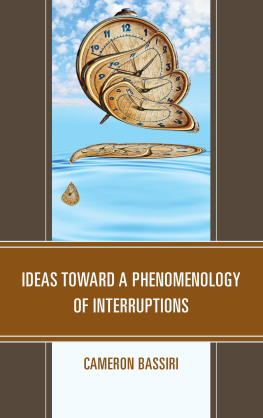
Topophobia
ALSO AVAILABLE FROM BLOOMSBURY
Phenomenology: An Introduction, Michael Lewis
The Ethics of Husserls Phenomenology, Joaquim Siles i Borrs
Flesh and Body, Didier Franck
Early Phenomenology, edited by Brian Harding and Michael R. Kelly
The Ethics of Time, John Manoussakis
Topophobia
A Phenomenology of Anxiety
DYLAN TRIGG
Bloomsbury Academic
An imprint of Bloomsbury Publishing Plc

For Audrey
[My patient] believed he had recently seen a work on agoraphobia in a bookshop window and was now looking through all the publishers catalogues in order to get a copy. I was then able to explain to him why his efforts were bound to be fruitless. The work on agoraphobia existed only in his phantasy, as an unconscious intention: he meant to write it himself.
FREUD, THE PSYCHOPATHOLOGY OF EVERYDAY LIFE
CONTENTS
All photos by the author.
Writing a book on the experience of anxiety and agoraphobia is a paradoxical task in many senses, especially when the experience is ones own. Notwithstanding the question of why one would undergo such a project, the very question of how such a book is possible remains an even greater enigma. Throughout this paradoxical aim, from its inception to its eventual completion, the development of this book has been shaped thanks to the generosity, patience and understanding of many people. Above all, this book owes its existence to the friendship and intellectual camaraderie of Dorothe Legrand. This book is rooted in discussions started at the Centre de Recherche en Epistmologie Applique before moving to the cole Normale Suprieure, and resurfacing time and again at Le Sully and Le Coude Fou. My gratitude in sharing this book with you is equal only to the appreciation I have for our friendship.
The experiences outlined and discussed in this book take place in Paris, principally between January 2011 and October 2011. Despite this localization, much of the book was written in Memphis, Tennessee, several years later. My thanks to colleagues at the University of Memphis, who, true to the spirit of Southern hospitality, have made my arrival in Memphis a warm and gratifying one. In particular, my thanks to Shaun Gallagher, Kas Saghafi, Verena Erlenbusch, Luvell Anderson, Mary Beth Mader, Andrew Daily, Tom Nenon, Somogy Varga and Connie Diffee. Thanks also to everyone at Cafe Keough, Memphis for providing a space to think, work, and drink in. In the midst of completing this book, Pleshette DeArmitt, Chair and Associate Professor of Philosophy at the University of Memphis, died suddenly. The philosophical community is a lesser place in the absence of her intellectual generosity and warm-hearted presence, and I will miss her greatly. Additional thanks to colleagues from the University College Dublin, especially to Dermot Moran, Joseph Cohen, Tim Mooney, Helen Kenny and Margaret Brady.
The research of this book has been supported from several funding bodies and institutions. I herein gratefully acknowledge the support of the Centre National de la Recherche Scientifique/VolkswagenStiftung for a fellowship at the Centre de Recherche en Epistmologie Applique (cole Polytechnique) and Husserl Archives (cole Normale Suprieure) (20112013); The Wellcome Trust for a visiting research position at Husserl Archives (cole Normale Suprieure (2013); The Irish Research Council for a fellowship at University College Dublin (20122014); and, principally, Marie Curie Actions (FP7-PEOPLE-2013-IOF 624968) for a fellowship at the University of Memphis and University College Dublin (20142017). My gratitude to all of these funding bodies for their support.
In addition, my sincere thanks to those colleagues who, with warmth and intellectual generosity, invited me to present some of the ideas detailed in this book in seminars, lectures and workshops in both Europe and the United States. Thanks above all to Bryan Norwood, Liam Heneghan, Melissa Pokorny, Annika Schlitte, Kevin Aho, Bruce Janz, Martin Nitsche, Anneke Smelik, Lszl Munten, Dianna Niebylski, Jeremy Northup, Justin Pearl, Tom Sparrow, Alina Popa, Irinia Gheorghe, Florin Flueras and Gretchen Schiller. Thanks also to Luna Dolezal and Kirsten Jacobson for their invaluable comments on aspects of this manuscript. My thanks, as ever, to my family for their love and support.
Let me also thank the speakers invited to several conferences and workshops organized by myself and colleagues over the last few years. For the Understanding the Body We Can Never Know workshop, which took place in Paris in October 2012, organized by Dorothe Legrand, Line Ryberg Ingerslev and myself, my thanks to: Pierre Henri Castel, Natalie Depraz, Thomas Fuchs, Kirsten Jacobson, Anneleen Masschelein, Helena de Preester and Manos Tsakiris. For the Is there a phenomeology of unconsciousness? conference, which took place in Dublin in February 2014, organized by Dorothe Legrand and myself, my thanks to: Joseph Cohen, Nataile Depraz, Dieter Lohmar, Tim Mooney, Dermot Moran, Alexander Schnell and Emmanuel de Saint Aubert. Finally, for the Phenomeology and Embodiment of Anxiety workshop, which took place in Memphis in March 2015, organized by Shaun Gallagher and myself, my thanks to: Drew Leder, Dorothe Legrand and Louis Sass.
At Bloomsbury, my thanks to Liza Thompson and Frankie Mace, who have graciously and warmly supported this project from the outset to its completion. My thanks also to Carrie Kania for her encouragement on this book.
It remains only to thank my wife, Audrey Petit-Trigg, pour ta tendresse, ta beaut, ton intelligence, pour tes jeux de mots, et pour ton amour. Your patient and loving presence, etched in this book in both a figurative and literal sense, is everything to me. I dedicate this book to you with love and appreciation.
Parts of were previously published in Continental Philosophy Review as The Body of the Other: Intercorporeality and the Phenomenology of Agoraphobia (Volume 46: Issue 3, 413429 (2013) and in Body/Self/Other: Phenomenology of Social Encounters (New York: SUNY Press) (2016) as Agoraphobia, Sartre, and the Spatiality of the Others Look. My thanks to the editors for their permission to publish these extracts.
Dylan Trigg, Memphis, Tennessee
A Vast Empty Place
The appearance of the Dirschauer Bridge, where the curve had a wide span, was an uncomfortable experience; during the times he had to cross it, a great feeling of anxiety overcame him, combined with the fear that he could become insane and would jump over the bridge during such a condition.
(CARL FRIEDRICH OTTO WESTPHAL, DIE AGORAPHOBIE)
The Pont Marie
13 March 2011. You are standing beside the Pont Marie, a small bridge positioned just off the Rue des Nonnains-dHyres. The bridge arches gently over the Seine before disappearing into the crowds on the le Saint-Louis. Out of view, the Pont Marie will continue until it merges with the Pont de la Tournelle, before resuming its journey on the Left Bank, at which point Paris will cease to be accessible to you. At the entrance of the bridge, you will re-enact a series of attempts at crossing the structure, each time finding yourself unable to master the unfamiliar terrain that divides you from the rest of the city. Faced with the prospect of navigating the bridge, your body emits a series of sensations and movements, which, despite being familiar to you, still mark the possibility of a trauma yet to be written into your flesh.
Next page

